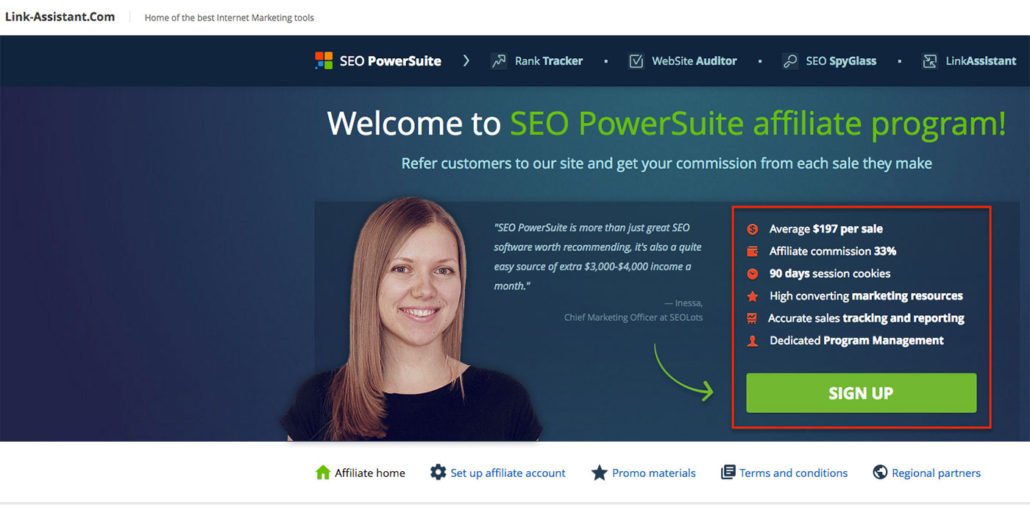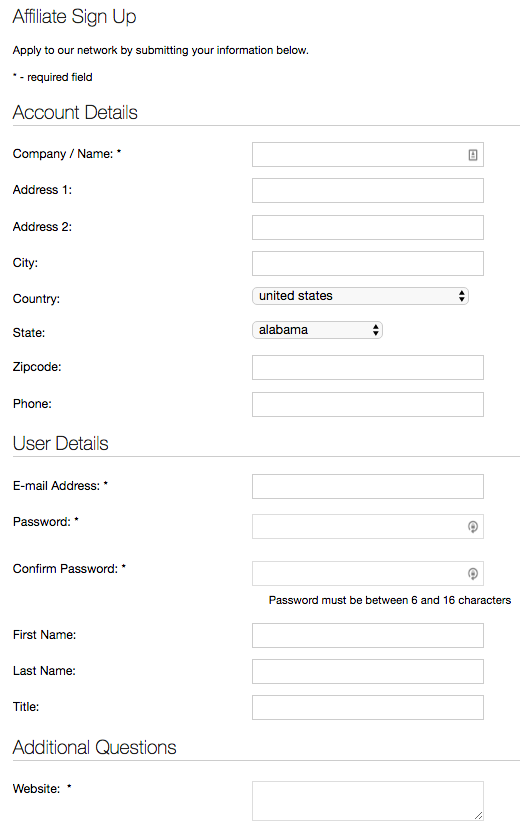3. Becoming a Merchant
Knowing about the benefits of affiliate marketing for merchants is enough to spark some interested in this performance-based strategy, but if you want to become a merchant, you will need to deeply understand what it entails and how to create and publish your affiliate program.What is a merchant?
A merchant is a person (or a company) that creates an affiliate program. Merchants are sometimes called advertisers, creators, sellers, or vendors. Anyone with a product they want to promote can become a merchant by creating an affiliate program. An entrepreneur, a startup or a large company are all possible merchants because participating in affiliate marketing process is not conditioned by a size of the business or an existing budget. In fact, merchants are required little or no investment at all. Costs of affiliate program management may occur, especially when using affiliate software or network, but the program needs no investment for affiliates because they are paid based on their performance. This means that only when the sale is finalized will the merchant issue a payment for the affiliate. As a merchant, your main responsibility is to have an affiliate program that works and correctly track transactions referred by the participants in your program. The management of this program requires software that will manage and track the performance of the affiliates and a person who will monitor the program and communicate with the participants in the program. You are also able to choose the affiliates you want to work with. The main reason why affiliates should apply and then go through the acceptance process is the fact that suspicious techniques and methods have always been a part of affiliate marketing. Merchants need their links to be promoted, but placing those links just about anywhere is not acceptable because it can actually harm your SEO and reduce your website search engine rank. This is why, you should create an application form for affiliates and choose criteria that should be met for an affiliate to become a member of the affiliate program. For example, you might want to focus only on one industry and select only the affiliates from that industry. Another requirement can be the location. In this case, you would only accept the affiliates from a specific countries. Other metrics can also be used to filter and select affiliates, such as page domain, Alexa rank, etc.How to become a merchant?
The process of becoming a merchant involves several phases during which you will prepare the program and everything needed before the program is published and officially available online for affiliates to join.Create a plan
The starting point is creating the plan. The central point of this plan is the product(s) or service(s) you want to sell through this affiliate program. You can choose one or several products (or services) depending on your business goals.
Image: https://unsplash.com/photos/aOYA7D3fse8
Budget
Creating and making the program available requires several things which include:- Affiliate platform costs
- Banners and other materials creation (or you can use DIY method)
- Landing page creation
Commission
The next step is determining the commission that will be paid to the affiliates. Have in mind that this information is usually available to the affiliates before they join the program, and it is one of the factors that will motivate them to join. The commission can range anywhere from 1% to even 100%. This depends on several factors:- Industry standards – These dictate the terms on the market, and they should be a guideline when determining the commission. You do not want to go too much below or above industry standards, to stay competitive.
- One-time payment vs. subscription – If you have a subscription-based service or product, your commission should be higher, because one referring visit from the affiliates will actually result in multiple purchases for you.
- Size and popularity of your brand – Brand recognition has an important role, and in affiliate marketing, large brands usually offer lower commission rates than smaller brands.
Cookie life
Cookie life is another part of affiliate program you will have to think about when creating a plan. There are no specific rules for determining an ideal cookie life, but when you do so, think about these:- Most internet users occasionally delete cookies (for example once a month)
- The largest percentage of sales occurs within a day of the click on the affiliate link
- Make sure you check your competitors and industry standards regarding cookie life
Terms of service
Terms of service or affiliate agreement is a document that regulates the terms and conditions that are valid for the affiliate program. Affiliates joining the program will have to accept those terms and conditions. This document helps you control the affiliate program and ensures you avoid and successfully deal with issues that might occur along the way. The document can regulate:- Affiliate obligations
- Prohibited activities
- Restrictions
- Merchant’s rights and obligations
- Access to the affiliate’s account
- Payment regulations
- Termination of agreement
- Disclaimer
- Limitations of liability
Description
Description of the affiliate program provides information for the affiliates who are interested in joining. Even though each description should be unique and you could style it any way you want, there are a couple of elements that are usually a part of every affiliate program description.- Details about the program
- Information related to the cookie life
- Data available for the affiliates
- Advantages of joining the program
- Information on how to sign up (or contact information)

Image: https://www.link-assistant.com/partners/affiliates.html
When creating the description, make sure the text is concise and focused only on what is most important for the affiliates to know before joining. This text should also persuade the affiliates to consider your program, so it needs to be engaging and interesting with perks of the program featured. Once you reach affiliates with this description, they can explore a more detailed explanation of the program and requirements in the terms of service document.Application form
Most merchants use an affiliate network to manage their programs, which is why application form is submitted through this network. This means that the affiliates should first join the network (or log in if they already have an account) and then they will apply. An alternative is to have an application form without going through the affiliate network application process. Instead, a merchant provides an application form which features affiliate’s information relevant to the merchant:- Company information
- Address
- User details
- Website URL
- Accepting the terms of service
- How did the affiliate find the program
- Does the affiliate have a strategy and a plan on how to promote the product
- Is the affiliate part of another (related) affiliate program

Email templates
Email templates are a part of the initial correspondence with the affiliates. They include acceptance (approval) email and denial email. With these emails you inform the affiliates about the status of their application and whether they had succeeded in joining the program. Since the text involved in this correspondence is usually pretty much the same, it is helpful to create these email templates. Approval email should also include:- The data about the program/company – Affiliates sometimes apply to multiple programs, so it is helpful to remind them.
- Activation promo – Some merchants like to offer a special promo to the affiliates, such as cookie life increase during the first month since the activation, or commission increase, etc. The goal of such promotion is to encourage affiliates to start working on advertising your program immediately.
- Affiliate links – To speed up the process, even more, you could send affiliate links that are already coded, so they can simply copy and paste them.
- Contact information – You want to be accessible to the affiliates for any doubts or questions they might have, so make sure you end the email with contact information.
- The reason for not accepting the affiliate – Usually, you will state “do not meet our approval criteria” as the reason. This is a generic reply, and it is perfect for an email template as it can be sent to all affiliates who are not accepted to the program. Occasionally, you might include the specific criteria that affected your decision, but this email contains more specific information and cannot be used as a general template.
- Contact information – Even if you decide not to accept a particular affiliate, you might want to leave the communication open by providing contact information. This way the affiliates can reapply if they fixed the issues that do not meet your criteria. Or, this simply gives them a chance to explain their strategy and why they applied for the program. In some cases, you might even reconsider the application. Additionally, denial email might be sent as a part of automated filtering and errors might occur. This is why it is essential to enable affiliates to contact you and ask for a personal review of their application.
Set up goals
The affiliate program is usually a part of your promotional strategy, and as such, it has goals you want to achieve. Thinking about goals in advance is going to help you choose the right approach, and it helps you evaluate the performance of the affiliate program. The most common goal affiliates set up is increasing sales. Since affiliates directly help you increase sales by promoting the product links, this strategy is perfect for expanding the base of buyers. However, other goals can be achieved as well, such as:- Generate leads
- Promote your brand
- Increase traffic
- Generate inbound links
- Expand your reach
Choose a network/software
Affiliate networks and/or software is usually a part of affiliate marketing process because they assist the creation, management, and control of the affiliate program. Before you become a part of affiliate marketing, you will need to explore features of both networks and software, to see how you can benefit from each, regardless if you are a merchant or an affiliate. This topic is a part of two separate chapters later on in this ebook.Promo material
Promo material is a part of the affiliate program, which is often referred to as affiliate creatives. It includes banners, brand assets, and other creative marketing materials that are made available to the affiliates for them to use when promoting your program. These materials are provided by the merchant and they should:- Be effective and engaging
- Have great graphics with readable fonts
- Have URL or phone number on the banner
- Feature a call-to-action
- Be free from grammar mistakes and typos
- Have a brand name or a logo
Strategy to promote the program
Finally, when you have everything needed to start your program, try to develop a strategy to promote the program. It is also a part of the process of becoming a merchant because your goal is to spread the word about the program. A strategy is a part of your plan that you create with clear goals and actions that will take you to that goal. When creating a strategy, think about this:- Objective goals – Consider your goals objectively and realistically to make sure you focus on something you can achieve.
- Determine the budget – Promotion of the affiliate program can include a specific budget which will be used for paid promotion. Think about your business, the expected benefits of this promotion and then based on that, determine the budget you are comfortable to invest.
- List the actions – This list includes the activities and the media you will use for the promotion of the program. Obviously, the website is the starting point, but you can also use paid search engines ads, social media, etc.
- Determine strategy’s KPIs (Key Performance Indicators) – The goal is to determine specific values which will help you evaluate the performance of your strategy. KPIs should be measurable and relevant to help you assess and analyze the outcome and the influence this approach has on your business in general.
